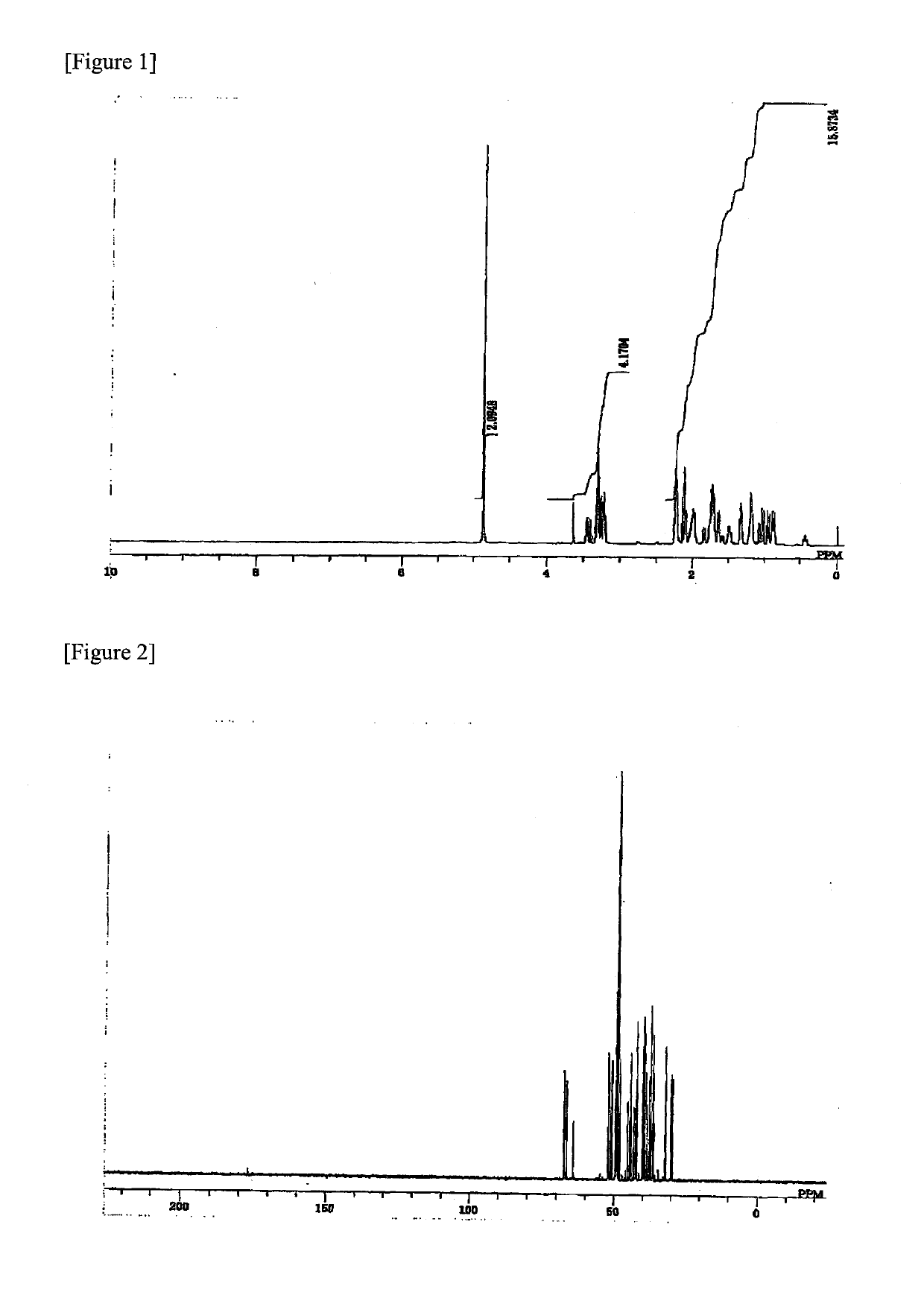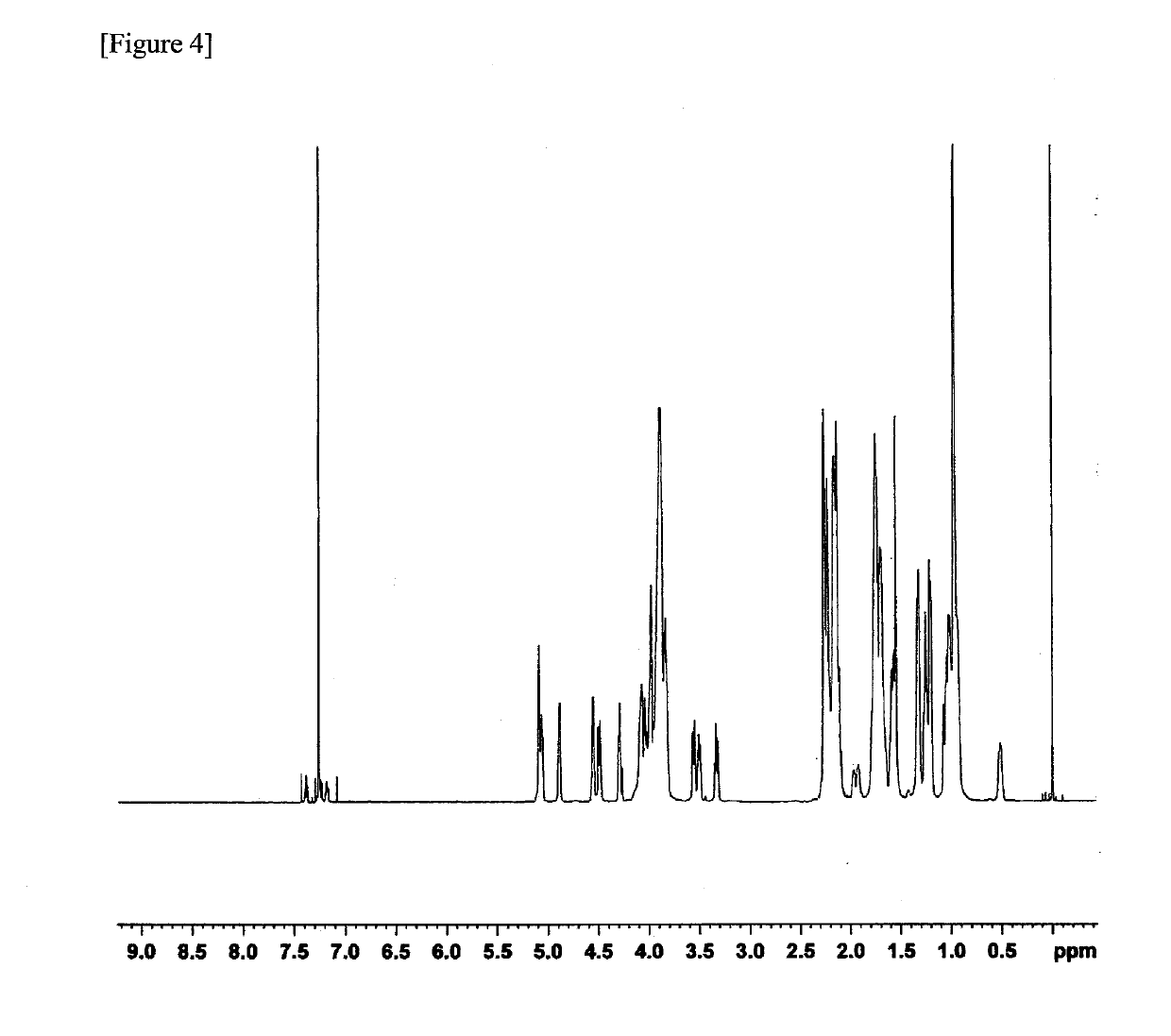Polycarbonate copolymer, optical lens and film in which said polycarbonate copolymer is used, and method for producing said copolymer
- Summary
- Abstract
- Description
- Claims
- Application Information
AI Technical Summary
Benefits of technology
Problems solved by technology
Method used
Image
Examples
example 1
[0126]34.40 g (0.155 mol) of D-NDM represented by formula (1a) obtained in Monomer Synthesis Example 1, 20.19 g (0.066 mol) of spiroglycol (SPG), 47.49 g (0.106 mol) of diphenyl carbonate and 0.22 mg (2.6 μmol) of sodium hydrogencarbonate were put into a 300 mL reactor equipped with a stirrer and a distillation apparatus, and it was heated to 215° C. over 1 hour under nitrogen atmosphere (760 Torr) and stirred. Heating was carried out in oil bath, and a transesterification reaction was initiated when the temperature reached 200° C. 5 minutes after the initiation of the reaction, stirring was started, and 20 minutes later, the pressure was reduced from 760 Torr to 200 Torr over 10 minutes. The temperature was increased to 210° C. while reducing the pressure, and increased to reach 220° C. 70 minutes after the initiation of the reaction. 80 minutes after the initiation of the reaction, the pressure was reduced to 150 Torr over 30 minutes, and the temperature was increased to 240° C. w...
example 2
[0129]24.90 g (0.112 mol) of D-NDM represented by formula (1a) obtained in Monomer Synthesis Example 1, 12.42 g (0.085) of isosorbide (ISB), 42.63 g (0.199 mol) of diphenyl carbonate and 0.19 mg (2.3 μmol) of sodium hydrogencarbonate were put into a 300 mL reactor equipped with a stirrer and a distillation apparatus, and the operation was carried out in a manner similar to that in Example 1 except for the feed amounts, thereby obtaining a polycarbonate copolymer.
[0130]Regarding the obtained polycarbonate copolymer, Mw was 45,000 and Tg was 145° C. Further, the refractive index was 1.521 and the Abbe number was 58.0. The total light transmittance was 89% and the water absorption rate was 1.1% by mass. The amounts of phenol, diphenyl carbonate and D-NDM in the obtained polycarbonate copolymer were 250 ppm, 100 ppm and 20 ppm, respectively.
example 3
[0131]30.02 g (0.135 mol) of D-NDM represented by formula (1a) obtained in Monomer Synthesis Example 1, 6.00 g (0.020 mol) of spiroglycol (SPG), 6.00 g (0.041 mol) of isosorbide (ISB), 42.09 g (0.197 mol) of diphenyl carbonate and 0.20 mg (2.3 μmol) of sodium hydrogencarbonate were put into a 300 mL reactor equipped with a stirrer and a distillation apparatus, and the operation was carried out in a manner similar to that in Example 1 except for the feed amounts, thereby obtaining a polycarbonate copolymer. The amounts of phenol, diphenyl carbonate and D-NDM in the obtained polycarbonate copolymer were 290 ppm, 100 ppm and 20 ppm, respectively.
[0132]Regarding the obtained polycarbonate copolymer, Mw was 40,000 and Tg was 131° C. Further, the refractive index was 1.519 and the Abbe number was 57.8. The total light transmittance was 90% and the water absorption rate was 0.6% by mass.
PUM
| Property | Measurement | Unit |
|---|---|---|
| Molecular weight | aaaaa | aaaaa |
| Ratio | aaaaa | aaaaa |
| Aliphatic | aaaaa | aaaaa |
Abstract
Description
Claims
Application Information
 Login to View More
Login to View More - R&D
- Intellectual Property
- Life Sciences
- Materials
- Tech Scout
- Unparalleled Data Quality
- Higher Quality Content
- 60% Fewer Hallucinations
Browse by: Latest US Patents, China's latest patents, Technical Efficacy Thesaurus, Application Domain, Technology Topic, Popular Technical Reports.
© 2025 PatSnap. All rights reserved.Legal|Privacy policy|Modern Slavery Act Transparency Statement|Sitemap|About US| Contact US: help@patsnap.com



